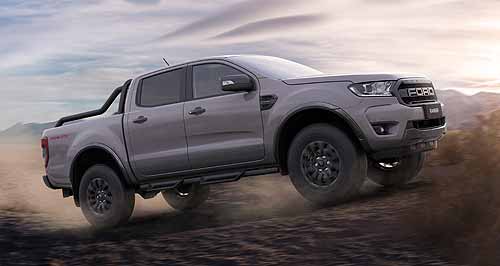Make / Model Search
News - Market Insight - Market Insight 2021Market Insight: Ford shows how buyer tastes swingChanging times: The Falcon (left) was once Ford’s sales ace, but that title is now firmly held by the Ranger pick-up (below). SUVs strong but a ute bonds its fortunes and no sedans wear Ford badgesGallery Click to see larger images 13 Apr 2021 By NEIL DOWLING FORD knows better than most how to follow trends and have the ability to discard models that have fallen out of favour with buyers.
That is, of course, the name of the game and why Ford has been playing for almost 120 years.
In Australia, there’s no escaping the fact that it was often king of the sales ladder in the 1960s and 1970s before competition with General Motors-Holden became so intense that they often split time on the podium.
Holden then ran the sales race from 2000 after Ford was the market leader in 1999, its last time in the sunshine until 2016.
The sales figures for Ford in 2010 showed it had 15 models in showrooms, many now consigned to front-bar conversations and memories and included the F250, Fairlane and Focus Coupe Convertible.
Its favorite in 2010 was the Falcon, with 29,516 sales for the sedan and wagon and an extra 9099 buyers for the ute. Ford had 95,284 sales that year and a 9.2 per cent market share, putting it third for the year after Toyota and Holden.
Ford buyers in that year were also recognising the presence of the SUV and increasingly chose this genre over traditional sedans and wagons, with the home-grown Falcon-based Territory hitting 11,558 sales to become the second-best selling Ford, ahead of the popular small-car (now light-car) Fiesta at 10,759.
The mid-size Escape SUV, then based heavily on the Mazda Tribute (the badges but not a lot else were different), was an alternative to other offerings from Japan (though the Escape/Tribute was built in Taiwan) but its rivals had an edge and the SUV started to fall from favour until retiring in 2013.
In 2010, Ford sold 3034 Escapes, almost triple the previous year’s 1039 sales, but by 2013 only 41 were sold, remaining stock after production ended in 2012.
The Escape was replaced with the Kuga that was more car-like but had less off-road ability, though historically was the right-sized SUV for Ford and Australians at the right time.
In 2012, Ford sold 1107 Kugas as the SUV demand increased but the Nissan X-Trail, Mazda CX-5 and Toyota RAV4 (each around 15,000 annual unit sales) dominated the medium SUV segment, suffocating the Kuga.
By comparison, the Territory hit almost 15,000 sales in 2012 in the large SUV category but in 2014, it turned down to under 10,000 units in a competitive market.
The 2014 turnaround for the Territory also spelled the end of the Focus as Ford’s top seller for the previous two years when it succeeded the Falcon.
Focus held on as a very popular small car against the SUV trend but the writing was on the showroom wall with a very unexpected shift in buyer demand – the ute.
The Ford Ranger 4x4 had bumped along at around 9000 annual sales from 2010 but the dual-purpose appeal grabbed attention in 2013 when it crept up to 17,000 annual sales and in 2014, countered the decline of the Focus, Fiesta and Territory by becoming Ford’s best seller with 20,674 units finding new owners.
By 2014, the Escape had ended its run, Falcon was down to just over 6000 sales for the year – about one-fifth of its sales only four years earlier – while Fiesta had halved its 2011 sales and Focus had begun its slide.
In 2015, Ford presented 16 models for buyers, including three Transits (counting Transit Heavy) and the Kuga, but more importantly had launched the right-hand drive factory-made Mustang.
Sales of the Mustang were brisk with pre-orders filling out the 121 units sold late in 2015 before the model really showed its potential with 6208 sales in 2016, mostly held back by demand leaping supply.
A new Escape/Kuga had also been launched, along with the slightly bigger Endura, intensifying Ford’s SUV offering as Territory started its retirement.
In 2017 the Mustang was Ford’s second-biggest seller at 9165 units, second only to the freight-train performance of the Ranger 4x4 that sliced through 36,000 sales at 36,932 and with its sights set on surpassing that annual figure.
Rationalisation in line with the demise of local manufacturing, and the swings away from sedan and hatchbacks to SUVs, made 2017 the last year of the Falcon (210 were registered) and the decline of the Fiesta (1550 sales on its way to only 532 the following year). Mondeo was also shown the door.
Ford’s Indian-made baby SUV, the EcoSport, was launched in 2013 to fill the SUV craze at the lighter end of the size and budget bracket, and went on to 2453 annual sales by 2015. But it was never a popular choice and slipped towards the bottom of the sales charts before Ford announced last year it was leaving the showroom.
The Endura also never found favour with sufficient buyers and it left in 2020, leaving the SUVs in Ford’s 2020 catalogue as the Escape, Everest and newcomer Puma.
But, startling for a company weaned on sedans and with a history of motorsport, it has no sedans (Focus is a hatch or wagon) in its portfolio and its cash-cow is a ute.  Read more |
Click to shareMarket Insight articlesResearch Market Insight Motor industry news |













Facebook Twitter Instagram